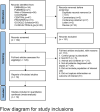Use of dexmedetomidine in patients with sepsis: a systematic review and meta-analysis of randomized-controlled trials
- PMID: 36029410
- PMCID: PMC9420168
- DOI: 10.1186/s13613-022-01052-2
Use of dexmedetomidine in patients with sepsis: a systematic review and meta-analysis of randomized-controlled trials
Abstract
Background: Dexmedetomidine is widely used in patients with sepsis. However, its effect on septic patients remains controversial. The objective of this study was to summarize all randomized controlled trials (RCTs) examining dexmedetomidine use in sepsis patients.
Methods: This systematic review and meta-analysis included RCTs comparing dexmedetomidine with other sedatives in adult sepsis patients. We generated pooled relative risks (RRs) and standardized mean differences and performed trial sequential analysis and a cumulative meta-analysis. The primary outcome was mortality, and the secondary outcomes were the length of the intensive care unit stay, duration of mechanical ventilation, number of ventilation-free days, incidence of total adverse event, incidence of delirium, and levels of interleukin 6, tumor necrosis factor alpha, and alanine aminotransferase.
Results: We included 19 RCTs that enrolled 1929 patients. Compared with other sedatives, dexmedetomidine decreased the all-cause mortality (RR 0.83; 95% confidence interval [CI] [0.69, 0.99]) and inflammatory response (interleukin 6 and tumor necrosis factor alpha levels at 24 h: standardized mean difference (SMD) - 2.15; 95% CI [- 3.25, - 1.05] and SMD - 1.07, 95% CI [- 1.92, - 0.22], respectively). Trial sequential analysis showed that it is not up to required information size. The overall risk adverse events was similar between dexmedetomidine and the other sedatives (RR 1.27, 95% CI [0.69, 2.36]), but dexmedetomidine increased the risk of arrhythmias (RR 1.43, 95% CI [0.59, 3.51]). Length of intensive care unit stay (SMD - 0.22; 95% CI [- 0.85, - 0.41]), duration of mechanical ventilation (SMD 0.12; 95% CI [- 1.10, 1.35]), incidence of delirium (RR 0.98; 95% CI [0.72, 1.33]), and levels of alanine aminotransferase and creatinine at 24 h were not significantly reduced.
Conclusions: Dexmedetomidine in sepsis patients could significantly reduce mortality compared with benzodiazepines but not with propofol. In addition, dexmedetomidine can significantly decrease inflammatory response in patients with sepsis compared with other sedatives. Dexmedetomidine might lead to an increased incidence of arrhythmias, but its safety profile did not show significant differences in the incidence of total adverse events. Future RCTs are needed to determine the sepsis patient population that would benefit most from dexmedetomidine and its optimal dosing regimen.
Keywords: Dexmedetomidine; Inflammatory response; Intensive critical care; Meta-analysis; Mortality; Sedatives; Sepsis; Survival.
© 2022. The Author(s).
Conflict of interest statement
The authors declare that they have no competing interests.
Figures
Similar articles
-
The Effect of Dexmedetomidine as a Sedative Agent for Mechanically Ventilated Patients With Sepsis: A Systematic Review and Meta-Analysis.Front Med (Lausanne). 2021 Dec 13;8:776882. doi: 10.3389/fmed.2021.776882. eCollection 2021. Front Med (Lausanne). 2021. PMID: 34966760 Free PMC article.
-
Effectiveness of dexmedetomidine versus propofol on extubation times, length of stay and mortality rates in adult cardiac surgery patients: a systematic review and meta-analysis.JBI Database System Rev Implement Rep. 2018 May;16(5):1220-1239. doi: 10.11124/JBISRIR-2017-003488. JBI Database System Rev Implement Rep. 2018. PMID: 29762314
-
Prognosis of dexmedetomidine sedation in patients with sepsis: a systematic review and meta-analysis.Minerva Anestesiol. 2025 May;91(5):450-461. doi: 10.23736/S0375-9393.25.18560-X. Minerva Anestesiol. 2025. PMID: 40501063
-
Perioperative dexmedetomidine reduces delirium in elderly patients after non-cardiac surgery: a systematic review and meta-analysis of randomized-controlled trials.Can J Anaesth. 2019 Dec;66(12):1489-1500. doi: 10.1007/s12630-019-01440-6. Epub 2019 Jul 1. Can J Anaesth. 2019. PMID: 31264195 English.
-
Dexmedetomidine Versus Propofol for Patients With Sepsis Requiring Mechanical Ventilation: A Systematic Review and Meta-Analysis.Front Pharmacol. 2021 Oct 14;12:717023. doi: 10.3389/fphar.2021.717023. eCollection 2021. Front Pharmacol. 2021. PMID: 34721015 Free PMC article.
Cited by
-
Use of dexmedetomidine in critical-ill patients: is it time to look to the actual evidence?Crit Care. 2023 Aug 29;27(1):332. doi: 10.1186/s13054-023-04618-z. Crit Care. 2023. PMID: 37644608 Free PMC article. No abstract available.
-
Dexmedetomidine increases the risk of delirium in critically ill patients: A propensity score analysis.Medicine (Baltimore). 2025 May 30;104(22):e42589. doi: 10.1097/MD.0000000000042589. Medicine (Baltimore). 2025. PMID: 40441198 Free PMC article.
-
Reinforcement learning model for optimizing dexmedetomidine dosing to prevent delirium in critically ill patients.NPJ Digit Med. 2024 Nov 18;7(1):325. doi: 10.1038/s41746-024-01335-x. NPJ Digit Med. 2024. PMID: 39557970 Free PMC article.
-
Association between dexmedetomidine sedation and mortality in critically ill patients with ischaemic stroke: a retrospective study based on MIMIC-IV database.BMJ Open. 2025 Jul 5;15(7):e101395. doi: 10.1136/bmjopen-2025-101395. BMJ Open. 2025. PMID: 40617611 Free PMC article.
-
Dexmedetomidine to Reduce Vasopressor Resistance in Refractory Septic Shock: α2 Agonist Dexmedetomidine for REfractory Septic Shock (ADRESS): A Double-Blind Randomized Controlled Pilot Trial.Crit Care Med. 2025 Apr 1;53(4):e884-e896. doi: 10.1097/CCM.0000000000006608. Epub 2025 Feb 28. Crit Care Med. 2025. PMID: 40019329 Free PMC article. Clinical Trial.
References
-
- Fleischmann C, Scherag A, Adhikari NK, Hartog CS, Tsaganos T, Schlattmann P, Angus DC, Reinhart K. Assessment of global incidence and mortality of hospital-treated sepsis. Current estimates and limitations. Am J Respir Crit Care Med. 2016;193(3):259–272. doi: 10.1164/rccm.201504-0781OC. - DOI - PubMed
-
- Evans L, Rhodes A, Alhazzani W, Antonelli M, Coopersmith CM, French C, Machado FR, McIntyre L, Ostermann M, Prescott HC, et al. Surviving sepsis campaign: international guidelines for management of sepsis and septic shock 2021. Intensive Care Med. 2021;47(11):1181–1247. doi: 10.1007/s00134-021-06506-y. - DOI - PMC - PubMed
-
- The First ESA European Sepsis Report — European Sepsis Alliance. https://www.europeansepsisalliance.org/news/2021/9/9/the-first-esa-europ....
-
- Rudd KE, Johnson SC, Agesa KM, Shackelford KA, Tsoi D, Kievlan DR, Colombara DV, Ikuta KS, Kissoon N, Finfer S, et al. Global, regional, and national sepsis incidence and mortality, 1990–2017: analysis for the Global Burden of Disease Study. Lancet. 2020;395(10219):200–211. doi: 10.1016/S0140-6736(19)32989-7. - DOI - PMC - PubMed
Publication types
Grants and funding
LinkOut - more resources
Full Text Sources






